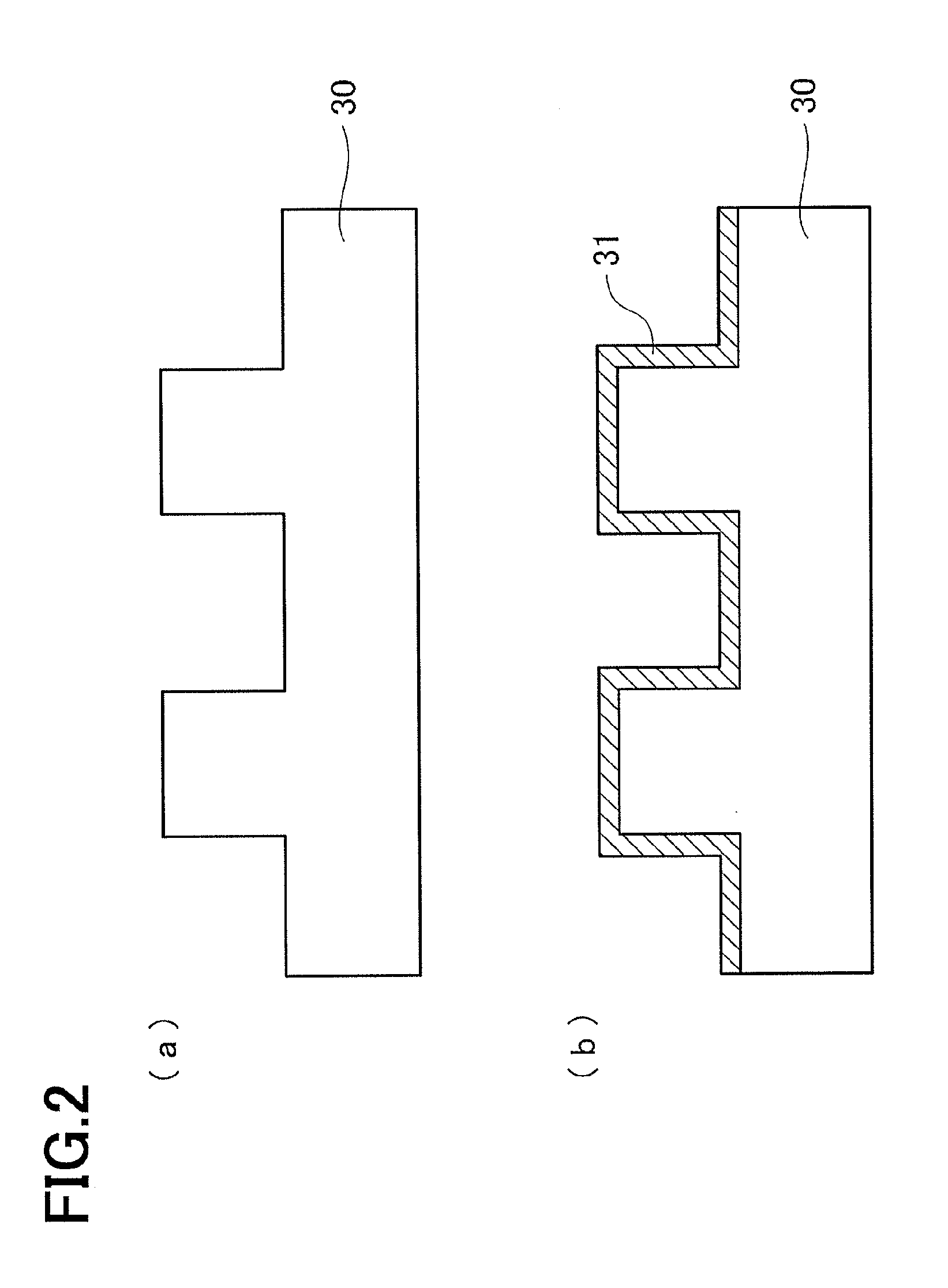Mold having release layer for imprinting, method for producing mold having release layer for imprinting, and method for producing copy mold
a technology of imprinting and release layer, which is applied in the field of molds, can solve the problems of conventional techniques facing the limit of densification, the magnetic influence between adjacent recording tracks or recording bits is no longer ignored, and the density of the magnetic medium has been further increased, etc., and achieves the effect of ensuring the quality of the mold
- Summary
- Abstract
- Description
- Claims
- Application Information
AI Technical Summary
Benefits of technology
Problems solved by technology
Method used
Image
Examples
first embodiment
[0057]An embodiment of the present invention is described below. The description is given in the following order. First, a step of disposing a release layer on a mold is described with reference to FIG. 2, which is a schematic cross-sectional view. Then, a step of producing a copy mold 20 from a master mold as an original by optical nanoimprint technology is described with reference to FIG. 3, which is a schematic cross-sectional view.
[0058]It is a matter of course that, in a case where a pattern is transferred using the copy mold, the copy mold may be provided with the release layer. In the embodiment, the mold includes the master mold for imprinting and a primary copy mold reproduced by transferring using the master mold, as well as a higher copy mold including a secondary mold, a third mold, and so on reproduced thereafter.
[0059](Preparing Mold)
[0060]First of all, a mold 30 that serves an original pattern for an uneven pattern to be transferred onto a copy mold 20 is prepared as ...
second embodiment
[0156]In the first embodiment described above, the copy mold 20 to be produced from the master mold for optical imprinting is described.
[0157]On the other hand, in this embodiment, the copy mold 20 to be produced from a master mold for thermal imprinting will be described. Note that portions not particularly mentioned in the following description are similar to those in the first embodiment.
[0158]To begin with, as a substrate used for producing the copy mold 20 from the master mold for thermal imprinting, a SiC substrate can be used. The SiC substrate has resistance against chlorine gas used in dry etching on the hard mask layer 7.
[0159]Other than the SiC substrate having resistance against chlorine gas, a silicon wafer that has a relatively low resistance against the chlorine gas can also be used for the substrate 1 for thermal imprinting, by giving the following treatment. Namely, a SiO2 layer is first disposed on the silicone wafer 1. Then, the hard mask layer 7 is disposed on th...
example
[0174]In this example, a mold 30 formed of a quartz substrate having a periodic structure with a depth of 30 nm, a depth at the recess (groove) of 15 nm, a depth at the protrusion (protruding portion) of 35 nm, and a pitch of 50 nm.
[0175]The mold 30 is dipped in a release agent compound for 5 minutes. The release agent compound includes the following compound (molecular weight of (C3F6O)n is equal to or larger than 500 and equal to or smaller than 6000) diluted to 0.5 wt % with VERTREL XF-UP (manufactured by Du Pont-Mitsui Fluorochemicals Co., Ltd, VERTREL is a registered trade mark).
[0176]Then, the mold 30 was pulled out from the solution of the release agent compound at a speed of 120 mm / min. The release agent compound was coated on through such a dip method.
[0177]Here, a plurality of samples were prepared and were each subjected to the heating at a temperature of 25 to 205 after being pulled out. Then, the mold 30 was rinsed. The rinsing was performed by 10 minutes dipping again ...
PUM
| Property | Measurement | Unit |
|---|---|---|
| temperature | aaaaa | aaaaa |
| temperature | aaaaa | aaaaa |
| width | aaaaa | aaaaa |
Abstract
Description
Claims
Application Information
 Login to View More
Login to View More - R&D
- Intellectual Property
- Life Sciences
- Materials
- Tech Scout
- Unparalleled Data Quality
- Higher Quality Content
- 60% Fewer Hallucinations
Browse by: Latest US Patents, China's latest patents, Technical Efficacy Thesaurus, Application Domain, Technology Topic, Popular Technical Reports.
© 2025 PatSnap. All rights reserved.Legal|Privacy policy|Modern Slavery Act Transparency Statement|Sitemap|About US| Contact US: help@patsnap.com



